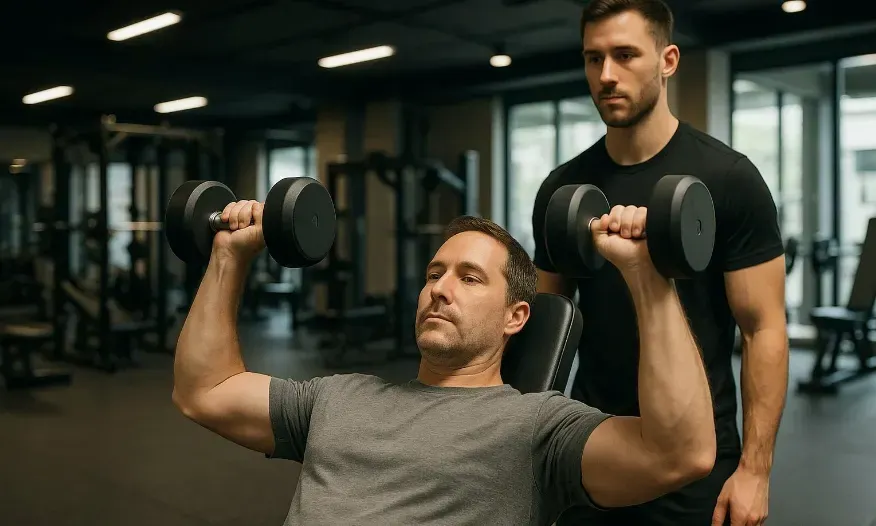Modern Men’s Low Testosterone Crisis — What’s Really Going On

Key takeaways
- Population data suggest men’s testosterone has trended down across recent decades.
- The biggest, fixable drivers: excess fat, poor sleep, chronic stress, sedentary time, and some chemical exposures.
- Weight loss, resistance + aerobic training, and better sleep reliably move testosterone up.
- EDC exposure is real; minimize plastics with heat and simplify personal-care products.
- Ejaculation timing affects semen parameters, not testosterone in a clinically meaningful way.
Why testosterone looks lower now (and why it matters)
Across cohorts in the U.S. and abroad, researchers report an age-independent decline in men’s total testosterone from the late 20th century into the 2000s. This isn’t just “men are older” math; even within age brackets, average values trended down. The exact contribution from each culprit varies by study, but the pattern is consistent enough to take seriously.
Why care? Testosterone influences body composition, insulin sensitivity, bone density, libido, mood, and vigor. Low levels often travel with central obesity, high triglycerides, and elevated fasting glucose—features of metabolic syndrome. In many men, improving metabolic health raises testosterone—especially through fat loss.
Metabolic health: the biggest lever most men control
Obesity, type 2 diabetes, and metabolic syndrome are tightly linked with lower total and free T and lower SHBG. Mechanistically, visceral fat increases aromatase activity (converting T to estradiol), while insulin resistance and inflammation suppress the hypothalamic–pituitary–gonadal axis. Weight loss—via diet, training, or combined approaches—tends to lift T in proportion to the pounds lost.Sleep debt and screens: the quiet testosterone killers
Testosterone’s daily peak leans on consolidated sleep. In a controlled study, one week of sleep restriction in healthy young men cut daytime testosterone by ~10–15%—without any other lifestyle change. Sleep fragmentation and late-night scrolling don’t just sap energy; they blunt the hormonal signal that supports muscle, mood, and libido.
Stress, cortisol, and the “can’t switch off” problem
Chronic psychological stress keeps cortisol elevated, which antagonizes anabolic processes and can dampen the reproductive axis. Experimental data show testosterone–cortisol interactions during stress tasks, and while the literature is nuanced, the everyday pattern is familiar: stressed men often report lower libido, poorer sleep, and worse training recovery. Build habits that lower baseline arousal—sunlight, walks, breath work, social connection—and protect them like appointments.Endocrine-disrupting chemicals: exposure and mitigation
EDCs such as BPA and phthalates can interfere with androgen signaling and are associated in observational studies with lower testosterone and impaired semen parameters. You can’t bubble-wrap your life, but you can cut avoidable exposure: minimize microwaving plastic, choose glass or stainless steel for hot liquids, and favor fresh foods over ultra-processed packaged options.
Sperm count trends, ejaculation myths, and what’s actually known
Sperm counts appear to have declined over the past half-century across multiple regions, though causes are multifactorial (metabolic health, smoking, chemicals, heat, etc.). That conversation often bleeds into testosterone myths about abstinence or “semen retention.” Here’s the grounded part: ejaculatory abstinence time affects semen parameters, not testosterone in any clinically meaningful way.
Longer abstinence increases semen volume and count, but excessively long gaps can worsen motility and DNA fragmentation; many labs and societies recommend about 2–7 days.
Pornography, compulsion, and mood: separating physiology from behavior
Frequent masturbation doesn’t meaningfully raise or lower testosterone for most men. However, compulsive sexual behavior can co-travel with mood disorders and distress; in those cases, the behavior is often a coping strategy rather than a hormonal cause. If use feels out of control or is crowding out relationships, work, or sleep, that’s a signal to address the underlying drivers (loneliness, depression, anxiety) and consider professional help.
A practical game plan to raise testosterone—safely and sustainably

You don’t need hacks; you need repeatable behaviors:
- Lose visceral fat if needed. Even 5–10% body-weight loss moves testosterone up; pair protein-forward eating with resistance and zone-2 cardio.
- Lift 2–4 days/week. Compound movements, progressive overload, and enough recovery to actually adapt.
- Walk daily. After meals is clutch for glucose control.
- Sleep 7–9 hours. Protect the window and the wind-down.
- Manage stress on purpose. Sunlight, breath work, social time, nature.
- Trim EDC exposure. Hot liquids in glass/steel; don’t microwave plastic; ventilate when cooking; choose fewer, better personal-care products.
If labs remain low with symptoms after a serious lifestyle block (e.g., 3–6 months), talk with a clinician about next steps and root-cause evaluation before considering pharmacologic therapy.
What counts as “low,” and when should you test?
Testing is more useful than guessing. Because testosterone follows a diurnal curve, measure total testosterone twice, early morning (typically 7–10 a.m.), on different days, with sex hormone–binding globulin (SHBG) to help estimate free T if needed. Evaluate thyroid function, fasting glucose/A1c, lipids, BMI/waist, ferritin, and sleep apnea risk—common, fixable drags on T.
Training specifics that help (and won’t fry your recovery)
Two to three full-body strength sessions weekly (squats/hinges/push/pull) plus two to three aerobic sessions (mix zone-2 and intervals) deliver the most bang-for-buck for body composition, insulin sensitivity, and sleep quality. More isn’t always better; if you bury yourself with volume and skimp on sleep, you’ll stall.Lifestyle levers with outsized ROI
Small hinges swing big doors. In practice, three levers drive most of the change: fat loss, sleep, and stress.
Nutrition that supports higher T (without fads)
Aim for a minimally processed, protein-forward pattern (roughly 1.6–2.2 g/kg ideal body mass), plenty of fiber (30+ g/day), and healthy fats (especially mono- and omega-3s). Adequate calories for your goal (deficit if losing fat, maintenance if lean mass focused) matters more than superfoods vs. villains. The win shows up as improved insulin sensitivity and body composition—key drivers of higher T.EDC-smart habits you can actually live with
- Use glass or stainless for hot beverages and food storage.
- Don’t microwave in plastic; avoid scratched plastic.
- Choose fragrance-free/simple personal-care products.
- Ventilate during cooking; wipe dust (EDCs hitchhike on dust).
Sex, semen, and testosterone—myths vs. facts
Testosterone doesn’t yo-yo meaningfully with day-to-day ejaculation patterns. If fertility is the goal, timing matters: 2–7 days of abstinence is the usual lab recommendation; excessively long gaps can increase DNA fragmentation despite higher counts. Sexual behavior is healthiest when it supports your relationships, mood, and sleep—not when it’s ruled by shame or magical thinking.
When to seek medical care
Get evaluated if you have persistent symptoms of low T, unexplained low values on repeat morning tests, or signs of pituitary disease (headaches/vision changes), testicular injury, or severe sleep apnea. If you and your clinician consider testosterone therapy, do it with eyes open—optimize lifestyle first, confirm an indication, and monitor carefully.The bottom line
Yes, modern pressures are real—and so are the levers within reach. Most men can move their testosterone by improving metabolic health, sleep, and stress, trimming EDC exposure, and training with intent. You don’t need perfection; you need repeatable habits that keep working long after the headline fades.
References:
· https://pubmed.ncbi.nlm.nih.gov/32151259/
· https://pmc.ncbi.nlm.nih.gov/articles/PMC3120209/
· https://academic.oup.com/jcem/article/110/9/e3125/8058933
· https://pmc.ncbi.nlm.nih.gov/articles/PMC4046332/
· https://pubmed.ncbi.nlm.nih.gov/36377604/
· https://academic.oup.com/humupd/article/23/6/646/4035689
· https://rbej.biomedcentral.com/articles/10.1186/s12958-025-01439-3
